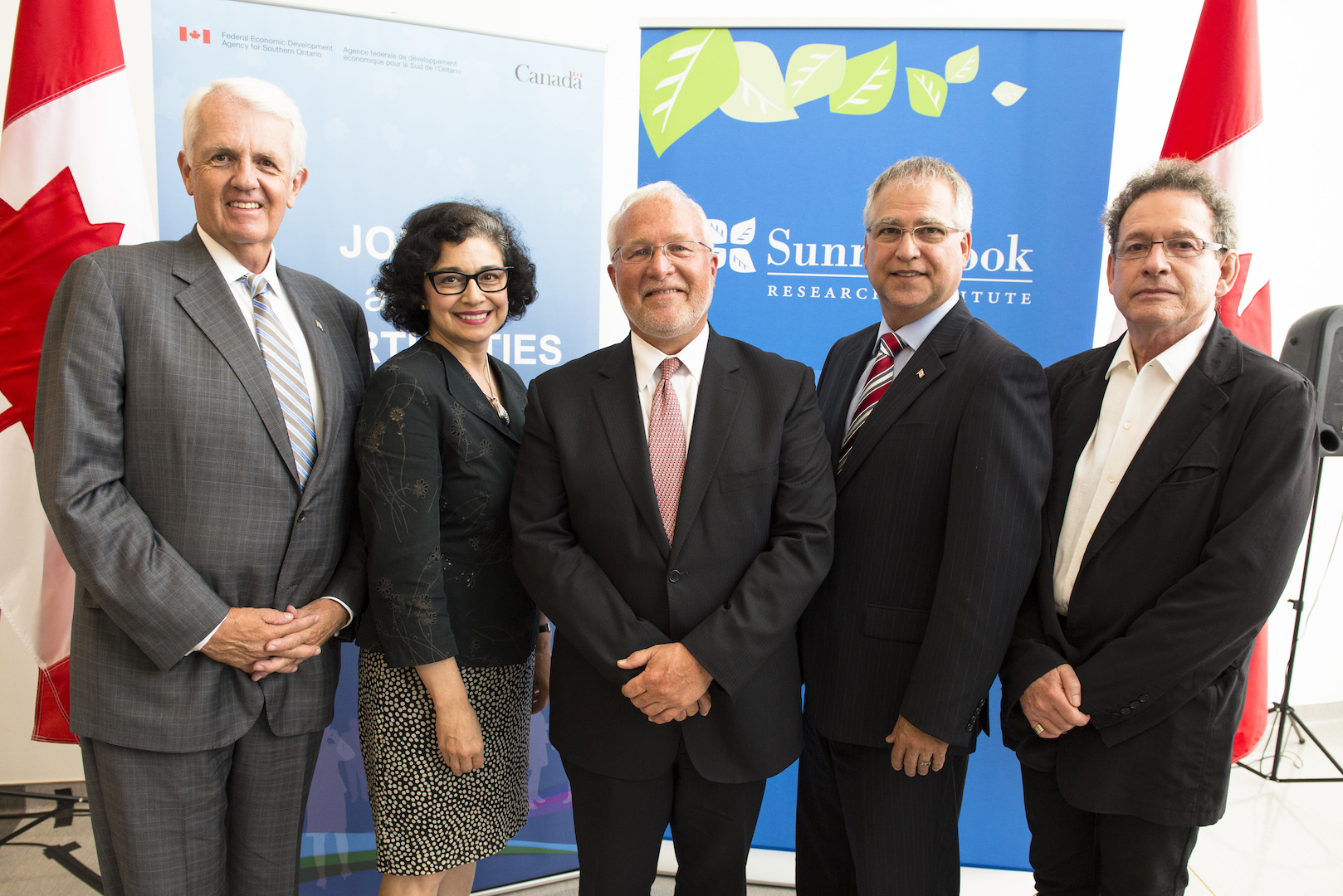In celebration of solutions
By Alisa Kim
On July 8, 2014, Sunnybrook Research Institute (SRI) hosted a celebration of the achievements of its Image-Guided Therapeutics Program. The program was launched two years ago through investment from the Federal Economic Development Agency for Southern Ontario (FedDev Ontario).
Dr. Barry McLellan, president and CEO of Sunnybrook Health Sciences Centre, was the event’s master of ceremonies. He welcomed the Honourable Gary Goodyear, Minister of State for FedDev Ontario, John Carmichael, member of Parliament for Don Valley West, and Karen Ellis, president of FedDev Ontario, to the event and spoke of the program’s success.
“I am proud that this investment, which was matched by Sunnybrook Research Institute; our academic partner, Western University; and 18 industry partners, has strengthened Ontario’s position as a leader in research in image-guided therapy and a hub of commercialization in this area,” said McLellan.
The event was held in the atrium on the sixth floor of the hospital’s M wing and was attended by SRI scientists and their teams, colleagues from other research institutes and industry partners collaborating on the projects.
FedDev Ontario invested $6.9 million into the program, which was matched by the private sector. In his keynote address, Minister Goodyear congratulated researchers and entrepreneurs on taking their innovations from ideas to sale-ready products. In particular, he noted two advances that show promise in changing medical practice.
“The work that’s being done at SRI really is revolutionary. We are seeing the use of focused ultrasound techniques to alleviate pain in cancer and the development of catheter technologies that allow medical professionals to look at real-time, 3-D images of the patient’s heart and blood vessels. This is the future of health care,” said Goodyear.
A closer look
After the speeches, McLellan and Dr. Michael Julius, vice-president of research at Sunnybrook and SRI, escorted Minister Goodyear and Mr. Carmichael to SRI’s device development lab for demonstrations of some of the technologies.
Dr. Brian Courtney, a clinician-scientist at SRI and CEO of Colibri Technologies, demonstrated the company’s intracardiac echocardiography catheter, which lets doctors see inside the heart and its larger vessels in three dimensions and in real time. It is the first device of its kind that allows physicians to look ahead of the catheter tip while advancing it through the anatomy safely.
Drs. Kevan Anderson and Garry Liu showed their technology, which enables clinicians to communicate wirelessly within a magnetic resonance imaging (MRI) suite during an intervention. Anderson and Liu are co-presidents of Innovere Medical, the SRI spinoff company that is commercializing the system, and members of the lab of Dr. Graham Wright, director of the Schulich Heart Research Program at SRI.
Dr. John Hudson and Ben Lucht, who work in the lab of SRI’s director of Physical Sciences, Dr. Kullervo Hynynen, showed a focused ultrasound device designed to relieve the pain of cancer that has spread to bone. The technology uses ultrasound imaging to guide the procedure, obviating the need for expensive MRI equipment, thereby making the procedure more affordable and accessible.
Dan Pajek, a PhD candidate in Hynynen’s lab, demonstrated a focused ultrasound system that can ablate tissue and open the blood-brain barrier within a small-bore preclinical MRI system. Focused ultrasound is the delivery of acoustic energy to a precise location in the body. The technology, which was taken from an early prototype to a commercial product with FedDev investment, enables research into use of the technique for drug delivery and new treatments for cancer, and diseases of the brain and heart.
Breadth of innovation
Afterward, other guests saw the demonstrations and other technologies developed through the Image-Guided Therapeutics program.
These were Vurtigo, visualization software that provides real-time imaging of anatomy and devices for guidance during cardiovascular interventions; a hardware platform for metabolic MRI of breast cancer to aid diagnosis and prognosis; a technique that provides 3-D and real-time localization of devices from X-ray imaging; and WaveCheck, a tool that noninvasively monitors chemotherapy response for women with breast cancer: it lets women and doctors know whether a treatment is working within weeks, not months.










